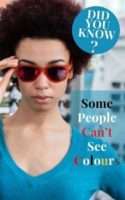I sat on the grass with my friend Greg, admiring the different shades of orange and blue in the sky.
“Beautiful, isn’t it?” I asked Greg.
He was quiet for a while, then he finally said, “I’m sure it is.”
It was then when Greg told me he was colour blind. I couldn’t believe that I did not know this about my own friend. I did not understand what it meant to be colour blind, until I did some research. I assumed that everyone can see colour, unless they are blind. But this is not the case.
What is colour blindness?
Colour blindness, also known as colour vision deficiency, occurs when you are unable to distinguish between colours, often the primary colours (red, yellow, blue). This can be problematic, especially when driving and having to stop at the traffic lights.
In the retina (a thin tissue layer at the back of the eye that contains light-sensitive cells) there are two types of cells that detect light. The rods and cones. Rods are responsive to dim light while cones are responsive to bright light. There are three types of cones that see colours namely red, green and blue. This is how the brain perceives colour.
How does it happen?
If one or more of the cones are absent, not working or if they detect different colours than usual, then colour blindness occurs. Severe colour blindness occurs when all three cone cells are absent. Mild colour blindness happens when all three cone cells are present but one cone cell does not work correctly. It detects a different colour than normal. In other words, all three cones need to be working properly and detecting the correct colour in order to have normal eyesight.
People with mild colour deficiencies can see colours normally in good light but have difficulty in dim light. Then there are others who cannot distinguish between certain colours in any light. Severe colour blindness is when everything is seen in shades of grey – this is rare.
When does colour blindness occur?
Colour blindness usually is from birth, however it can develop later on in life. That being said, change in colour later on in life could signal an underlying heath issue and those who experience it are advised to see an ophthalmologist.
What are the symptoms of colour blindness?
• One of the first signs is having trouble seeing colours and the brightness of colours.
• Another sign is having an inability to tell the difference between shades of the same or similar colours.
Colour vision problems occuring later in life are a result of:
• Metabolic Disease
• Trauma
• Toxic effects from drugs
• Vascular disease
Who is at risk for colour blindness?
Having certain conditions may increase your risk for acquired colour deficiency, including:
• Glaucoma
• Diabetes
• Macular degeneration
• Alzheimer’s disease
• Parkinson’s disease
• Chronic alcoholism
• Leukaemia
• Sickle cell anaemia
Certain drugs, such as the drug hydroxychloroquine (medication treating rheumatoid arthritis, malaria and lupus) may also increase your risk for acquiring colour blindness.
What tests and treatment can be done?
A simple test can be conducted with an ophthalmologist. The test consists of showing you a pattern made up of multi-coloured dots. If you do not have a colour deficiency, you will be able to see numbers and shapes among the dots. If you are colour blind, you will have a hard time finding the number or shape in the pattern.
If you are born with colour blindness, there are special contact lenses and glasses that may help. If you developed colour blindness over time, the ophthalmologist can treat it by addressing the underlying condition or drug that caused the problem.
If you can’t make your way to an ophthalmologist, you can use a set of images called the Ishihara colour plates. It is one of the most common and most reliable tests.
To do the Ishihara test, you must look at the images, which have numbers embedded in dots of colour. The numbers are a different colour to the background. If you can’t see the numbers, you may be colour blind.
If you find that you are colour blind, there is no reason to panic. With rare exceptions, people who are living with varying degrees of colour blindness don’t necessarily live in a colourless world. There are many resources available to help with the condition.
***
Have you ever wondered if dogs are colour blind? Read here to find out.
Tell us: What have you learned about colour blindness?

